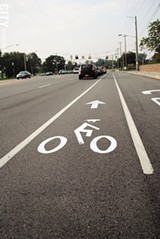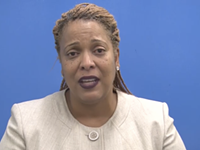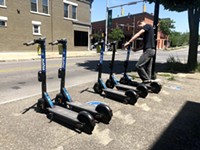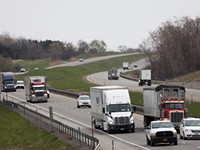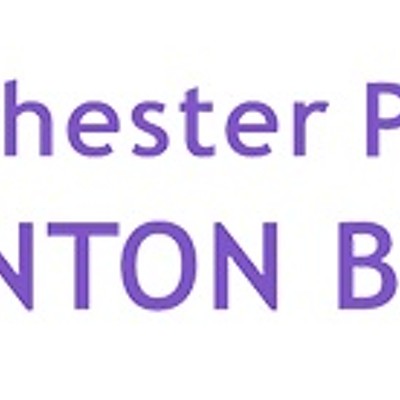[
{
"name": "500x250 Ad",
"insertPoint": "5",
"component": "15667920",
"parentWrapperClass": "",
"requiredCountToDisplay": "1"
}
]
Imagine taking a relaxed, pleasant bike ride on one of Rochester's moderately busy streets — coexisting peacefully with cars and enjoying the scenery. But then the lane just ends at an intersection or in a spot where the roadway narrows. Suddenly, you're forced into the street.
"To the casual observer, you're riding along and you have accommodation, and then it stops, and it's hard to understand why that happens," says Glenn Cerosaletti of Brighton, who bikes roughly 2,000 miles a year, much of it in the City of Rochester. He's also on the board of the Rochester Cycling Alliance advocacy group.
Fragmented bike lanes are a problem in the city, especially for inexperienced or casual cyclists.
Rochester has installed 41.3 miles of bike lanes and added shared-use markings to 26.1 miles of driving lanes over the last five years. The city also rolled out bicycle boulevards: marked routes that parallel high-traffic roads on lower-volume, easier-riding neighborhood streets.
The efforts began in earnest after the rollout of the city's 2011 Bike Master Plan, which showed how Rochester could better accommodate cyclists. City officials will refresh that document as part of the ongoing Comprehensive Plan update.
"We've certainly got a lot of room to improve and we're committed to doing that," says Erik Frisch, the city's transportation specialist.
The League of American Bicyclists recognized Rochester as a Bronze-level Bicycle Friendly Community in 2012 and renewed that designation in November. Cycling advocates and officials want to try for Silver-level status when the city reapplies in 2020. But to earn the designation, Rochester will need to make substantial gains.
For example, the League wants city officials to convene a bicycle and pedestrian advisory committee, devote more transportation funding to bike projects, and add more bike accommodations to city streets. It wants more people to commute by bike, too.
The League also wants to see a drop in car-bike collisions in Rochester and better educational efforts; the city and some local organizations plan to partner on an education and outreach campaign.
"I do feel like the city has been very proactive," Cerosaletti says.
The city needs more protected bike lanes, which incorporate a barrier between riders and automobile traffic, to truly boost the number of people cycling around Rochester, Cerosaletti says.
"Those are the sort of accommodations that are going to be more comfortable for casual cyclists and they're really going to open the door for more people, whether they're young or older, or simply aren't accustomed to getting out regularly," he says.
The city is working on it. It's building a cycle track as part of the project to fill in a portion of the Inner Loop, for example. Cycle tracks tie into intersections and are essentially parallel, bike-only streets.
Alex Freeman goes on a bike rant from CITY Newspaper on Vimeo.
The Inner Loop track will cover three-quarters of a mile from the Howell-Monroe-Chestnut intersection to University Avenue. It's supposed to be finished next year, as is another track on Elmwood Avenue, alongside the University of Rochester campus.
Cycle tracks will likely be included in future road projects. The city tried to include one that would have started downtown and ended at North Goodman Street into next year's East Main Street resurfacing project. But funding constraints limited the city to bike lanes instead.
The city also installed removable reflective posts along the North Chestnut Street bike lanes between Main Street and the University-Andrews intersection; the posts will be removed for the winter plowing seasons. It plans to use similar posts to buffer bike lanes on the Broad Street bridge, which is currently being resurfaced.
But some tight, high-volume roads continue to pose challenges, and several lack bike accommodations, says Richard DeSarra, another Rochester Cycling Alliance board member. For example, Lake Avenue only has bike lanes north of Route 104, even though it's an important north-south route. The southern section doesn't have enough space to add lanes.
Lake is a problem for drivers, pedestrians, and cyclists, largely due to its design, traffic volumes, and the speed some drivers travel. Any fixes will probably be complicated and costly, since the road would have to be redesigned and rebuilt.
In cases such as Lake Avenue, however, the city can provide alternative routes, which is where bicycle boulevards come into play. Planners have laid out 50 miles of routes around Rochester, says the city's Frisch.
The city completed its first bike boulevard this year along Hillside Avenue, Harvard Street, and Canterbury Road. It has two planned for 2017, with more possible if state or federal funding comes through.
One route will follow Pershing Drive and Lyceum Street, paralleling difficult sections of North Goodman and Culver Road. The other will pass through Bartlett Street, Frost Avenue, and Rugby Avenue in the southwest.
"You have to look at developing an interconnected, citywide, low-stress bike network," Frisch says. "And that's going to consist of bike boulevards, the trails, and protected lanes."
A couple of other lingering problems frustrate cyclists, even infrequent riders.
Certain traffic signals are a pain because bicycles won't activate the sensors that trigger the lights. Riders can wait until a car rolls up, or they can make a break for it if they see a gap in traffic. The latter solution isn't safe (or legal), but it's common.
City staff and local cycling advocates are working with Monroe County on the problem, since the county operates the city's traffic signals. The county will place video detection equipment at intersections that are part of bike boulevards or that have certain bike accommodations, Frisch says.
Parking can also be a problem. The city, neighborhood groups, and local businesses have installed bike racks all over the place. Still, in some areas, there aren't enough racks or there's no place to securely lock up a bike.
The solution is to ask for a rack. City staff members review the requests and install the racks as long as they're in public areas and will receive adequate public use. Advocates say the city has been very responsive to requests.
City officials also hope that Rochester's new Zagster-operated bike share system, which opens next year, relieves some of the bike parking anxiety. People will be able to check out a bike at one station and drop it off at another.
"Arguably, the No. 1 thing that's going to prevent somebody from riding a bike to the store, to meet friends at a bar, whatever the case may be, is if there isn't adequate and reliable bike parking," Frisch says. "We're never going to get anywhere if there isn't that.
